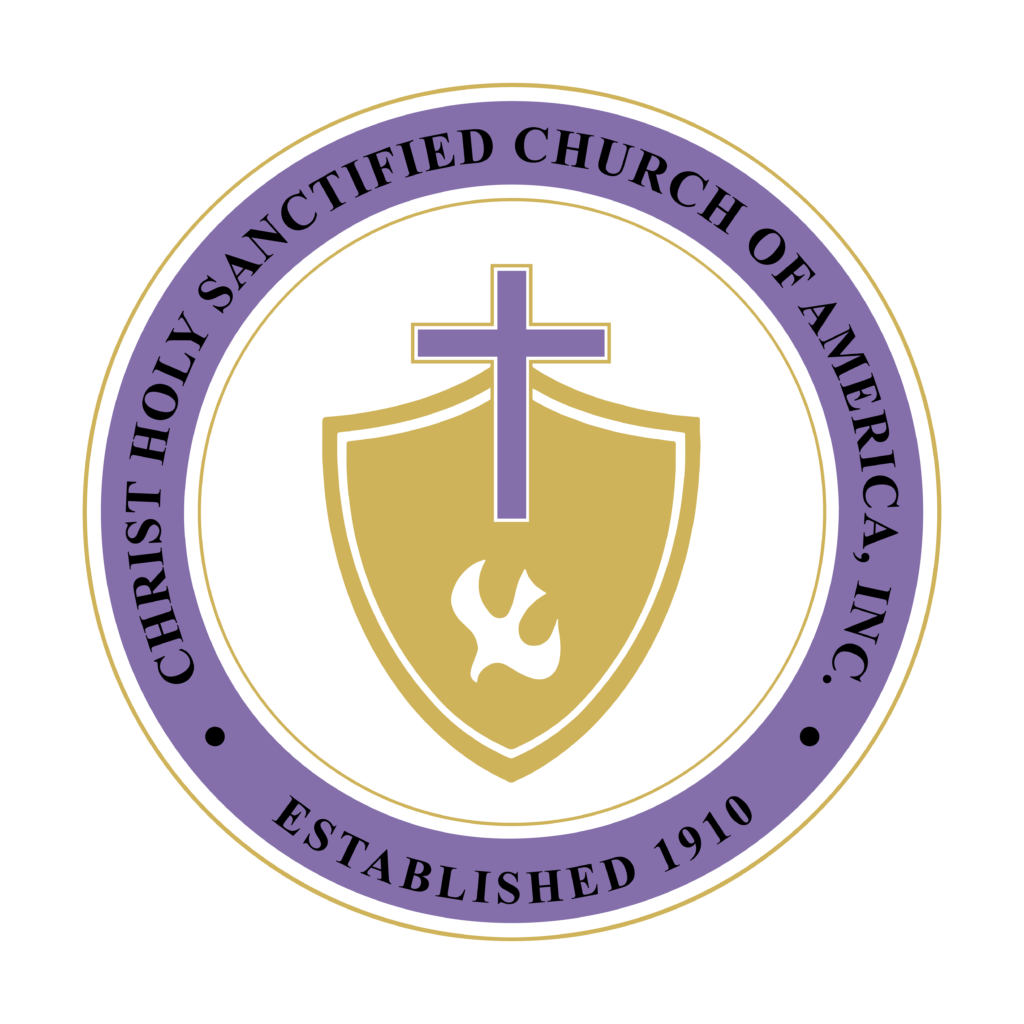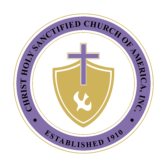Christ Holy Sanctified Church of America - A Brief History
The news of the outpouring of the Holy Ghost in 1906 on Azusa Street, in Los Angeles, California had not yet reached Lake Charles, Louisiana; however, this same spiritual and Divine power of the Holy Ghost experienced in Los Angeles was also in Lake Charles – 1,750 miles from Los Angeles. Hearing about this sanctified group in Lake Charles, Elder W.J. Seymour, on his way to Tennessee, came through Lake Charles and stopped by the home of Mother Mitchell, Sarah King’s mother. Elder Seymour heard about this sanctified group in Lake Charles and taught them and explained to them what they had experienced, encouraging them to continue and God would reveal Himself in marvelous ways to them.
As Elder Seymour took his leave, the Saints in Lake Charles were joyous of his coming, and they grew and waxed strongly. They bore their burdens in the heat of the day. And, in that area, Pentecostalism grew in the midst of sanctified people. But the doctrine was strange and they knew little about Theology. All they truly knew was that God had sanctified them and baptized them with the Holy Ghost, and they spoke in tongues as the Spirit gave them utterance. Because of their youth and being new at this religious experience, they were continually challenged on the doctrine they preached.
In 1910, the Christ Holy Sanctified Church of America, Inc. was incorporated and chartered. This came about shortly after Judge and Sarah King were dropped from the membership roll of their former organization (Christ’s Sanctified Holy Church, Joseph Lunch, founder) because they taught on New Testament ordinances such as foot washing, communion, and water baptism. Even though they were asked to join other organizations that were older, these organizations were not Pentecostal or dominantly sanctified. Therefore, they called S.A. York, T.D. McAllister, and others (white Saints) to come and help them in their plight as they pondered the next step. Judge and Sarah King were counseled to, “Stand fast in the liberty of Christ, who has made us free, and not be entangled with the bondage, affairs and cares of this world.” These men advised them to form their own group and call it, “Christ Holy Sanctified Church,” in which, after much discussion and counseling, they agreed. They preached nothing but sanctification and total abstinence from worldly pleasures.
In 1914-15, Bishop C.H. Mason came into the area. Judge King, C.H. Mason, and C.P. Jones were preaching in Louisiana, East Texas, and Mississippi. In those early days, these men and women of God were not known as Bishop or Reverend – everyone was “Brother or Sister.” Holiness, sanctification, and the Baptism were stressed during those years of infancy of this great outpouring as the church began to grow.
In the coming years, Judge King moved into East Texas setting up churches everywhere he went. His brother, Joe King, along with many others, came to him and was sanctified. Joe King became one of the outstanding ministers of Christ Holy Sanctified Church. Judge King continued moving westward and as early as 1916-17, he was in Beaumont and Houston, Texas. In 1918, taking his family and two church members, Judge King went to Los Angeles, California beginning a delightful and exciting relationship and fellowship with other Pentecostal men and women of God in the Los Angeles area.
After being deserted by the two church members, Judge King began fellowshipping with whomever the Spirit of the Lord directed him. As a strong preacher (accompanied by his brother, Joe), Judge was loved by many as he sang and preached; his two sons, Ulysses and Saunders, sang and played the banjo, guitar, and piano as thousands of souls came to the Lord. As a result of Judge King’s charisma and anointing, there were some in the Los Angeles area who donated or willed church properties to him and the Christ Holy Sanctified Church in the furtherance of the organization. Despite Judge King having the rights to these properties, he did not believe in striving with those who did not want him to have these properties. As said by Bishop Ulysses King, Sr., “We did not believe that the church’s affairs involving the Saints of God should ever be settled by the court system.” And, because of the fellowship and friendships with E.R. Driver of the Church of God in Christ, W.M.A. Washington of the Church of Christ Holiness, and Aimee Semple Mc Pherson of Angelus Temple Foursquare Church, Judge King did not to set up assemblies in Los Angeles during those early years but opted to keep the peace among the brethren.
In 1923, Judge King left Los Angeles and went to Weed and Oroville, California setting up churches in both towns. Unfortunately, due to religious hatred and racial prejudice, the Oroville church building was burned down by arsonists who set fire to the building. These men later confessed saying, “We resented the singing, shouting, and the music.” But persecution did not block Judge King as he moved on to Fresno, California. Choosing Fresno was as a result of Judge King’s acquaintance with Mother Emma and Elder Henry Cotton, and this opened many doors to a wide fellowship with many other holiness groups. The Cottons were extremely dear and close to the ministry of Christ Holy Sanctified Church.
In 1925, Judge and Sarah King moved to Oakland, California after setting up churches in San Francisco. New doors opened as Judge King began preaching on 7th Street in West Oakland; thousands of souls were saved and baptized with the Holy Ghost and, for many years, Oakland, California became the center of his ministry. But the fountainhead of the organization, Louisiana, was not neglected or forgotten. Year after year, conventions were held in Louisiana with those who had not been persuaded or proselytized into other groups; they all came back to Louisiana where it was hoped a large convention site would be erected. But because of the lack of unity, the convention site was never built and the convention was later moved from Louisiana to Jasper, Texas where it remained until 1945.
In 1939, evangelism crusades and powerful revivals started sweeping the southern and mid west portions of the United States. Mother A.L. Money who was small in stature but a giant spiritually, preached under the power of the Holy Ghost. Men laid down their guns, tore down their whiskey stills, and stopped their gambling after they became sanctified. Women started dressing modestly, taking care of their children, and stopped dipping snuff after they were delivered from the bonds of sin. A great harvest of souls came into the Christ Holy Sanctified Church, and many of those who were saved in “thirty nine” (1939) became prominent leaders in the church.
After the death of Bishop Judge King in 1945, there was dissension by T.S. Horn, T.W.S. Reed, E.J. Derritt, and others regarding the replacement of the senior bishop. The dissension caused a separation of the organization forcing those remaining with Christ Holy Sanctified Church to change the national convention from Jasper, Texas to Beaumont, Texas. The young Elder Ulysses S. King, Sr. was called in from college to be the new senior bishop of the organization. Out of this dissension came guidelines for the church in 1946. Those pressing issues of these guidelines were Mother Sarah A. King, Elder U.S. King, Sr., Mother A.L. Money, Sister Lucille Shrock, Sis. Ruth Jones, Elder S.O. Walton, and Sister Marie Walton. These individuals made up the guidelines for the future of the organization in its ruling body and structure.
The harvest of souls in 1939 was just the first wave of a great harvest. Another exciting revival outpouring took place in 1949 with a year long, continual revival. One of the outstanding husband and wife evangelistic teams was Elder Whitley and Sister Geneva Jaubert-Smith, who became one of the most prominent evangelical teams in the southeast region. They worked as laborers for the Gospel in Daisetta, Texas, Ames, Texas, Belgrade, Texas, Beaumont, Texas, Fort Worth, Texas and New Llano, Louisiana. More souls came to the Lord; the church grew more as these young converts spread out pioneering new congregations in various hamlets and suburbs. And, many of those saved in 1949 elevated to the ranks of superintendents, overseers, bishops, and presiding bishops of Christ Holy Sanctified Church.
The organization would continue to spread and grow in the South. There were many who donated land and other properties to the furtherance of the organization. One such person was Rev. Mrs. Lucille Shrock (first female superintendent), who donated acres of land where the national temple would eventually be built in Beaumont, Texas.
Throughout the 20th century, Christ Holy Sanctified Church of America, Inc. continued planting churches in the United States, Mexico, and West Africa and remained in fellowship with many Pentecostal denominations, such as Assemblies of God, Church of God in Christ, Federated Pentecostal Churches, International, International Church of the Foursquare Gospel, as well as nondenominational organizations, Methodists, Baptists, and any organizations upholding and proclaiming the Gospel of Jesus Christ.
Despite two significant separations from the organization (1945, Christ Holy Sanctified Church, Independent – Bishop James Moss; 2006, Good News Fellowship – Bishop Billy R. Brown), the organization continues to thrive in the 21st century as new churches are planted, birthed, and independent congregations/organization are joined into CHSC.. There is also new and significant growth in Uganda, Liberia, and Nigeria, Africa.

